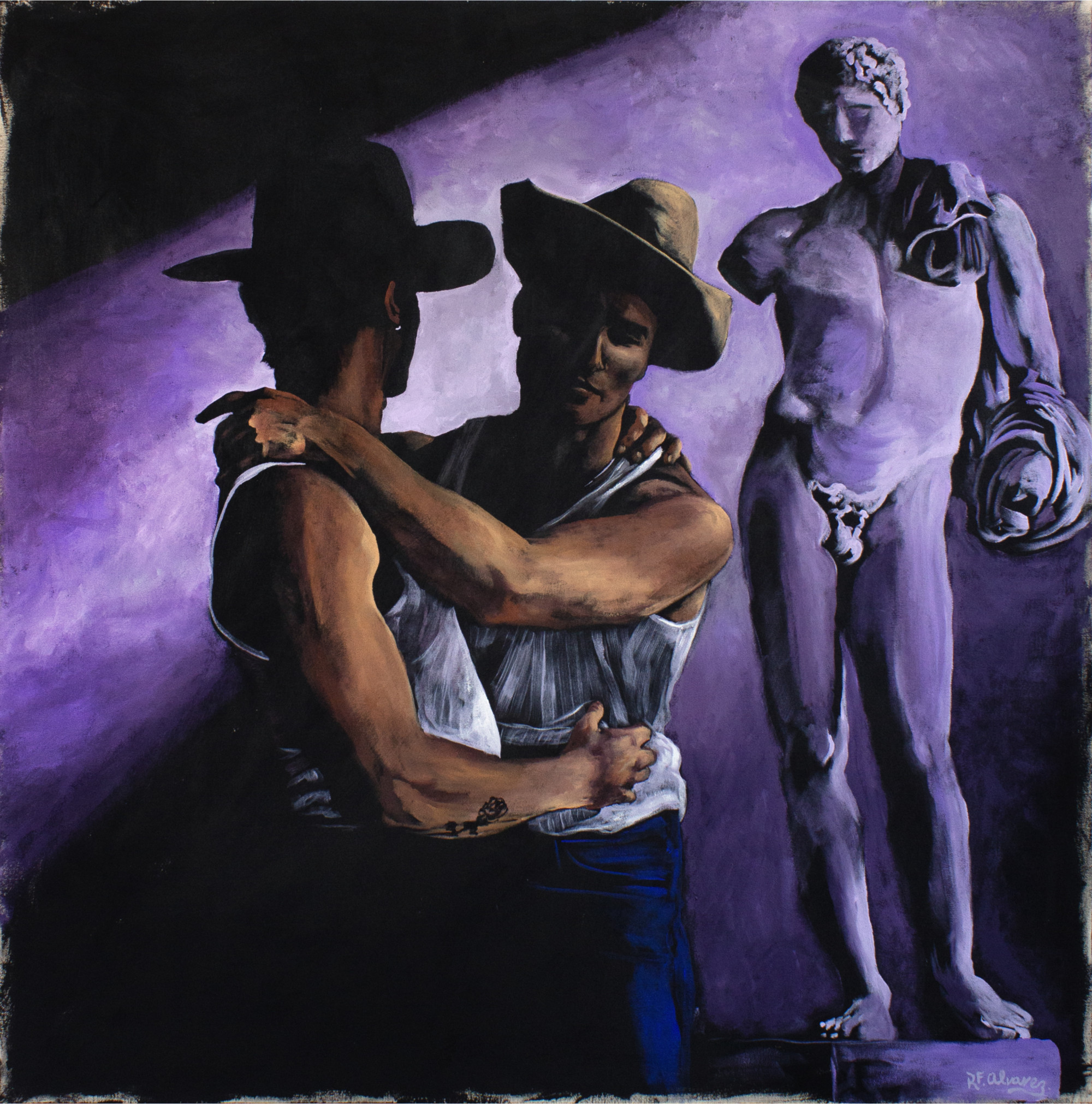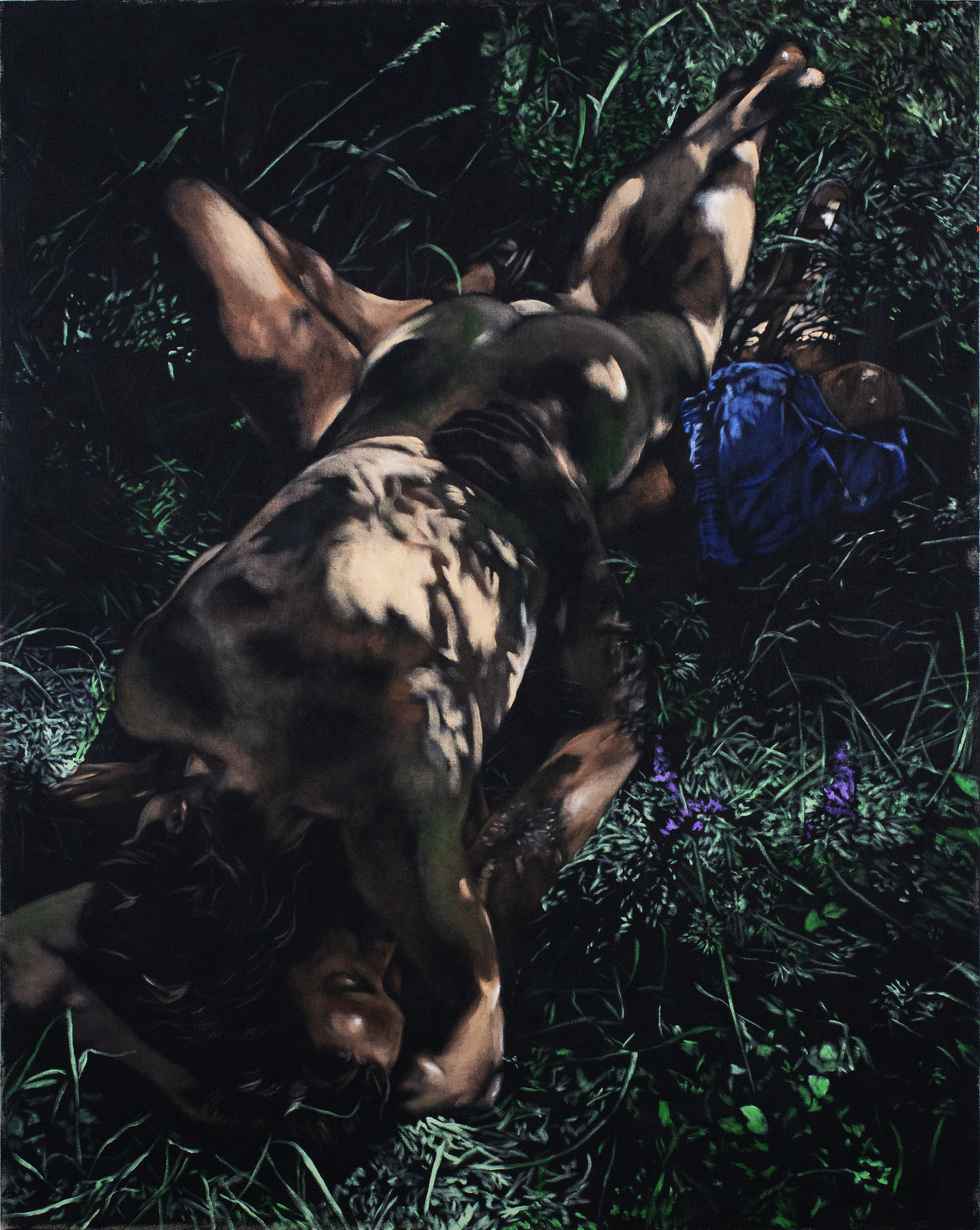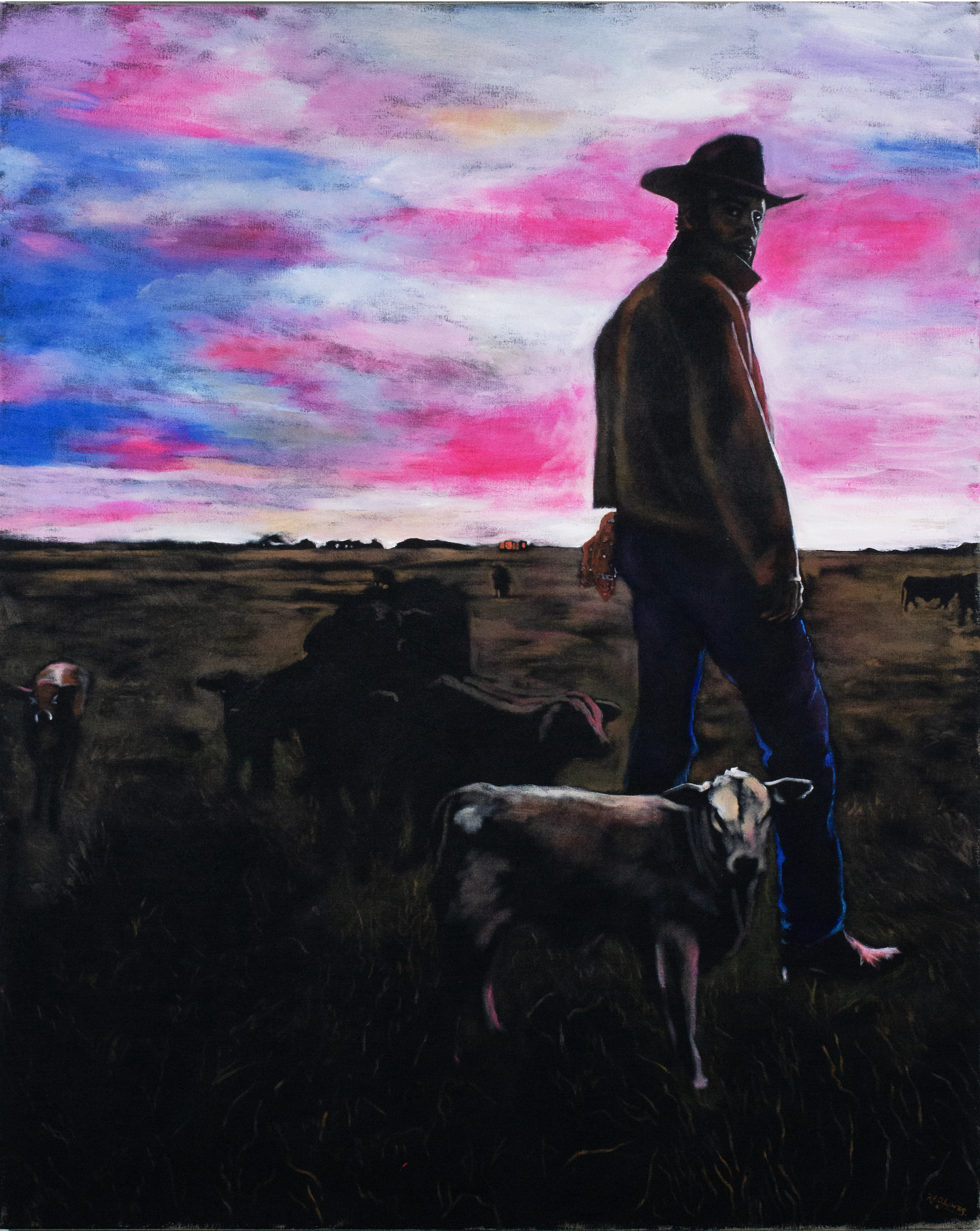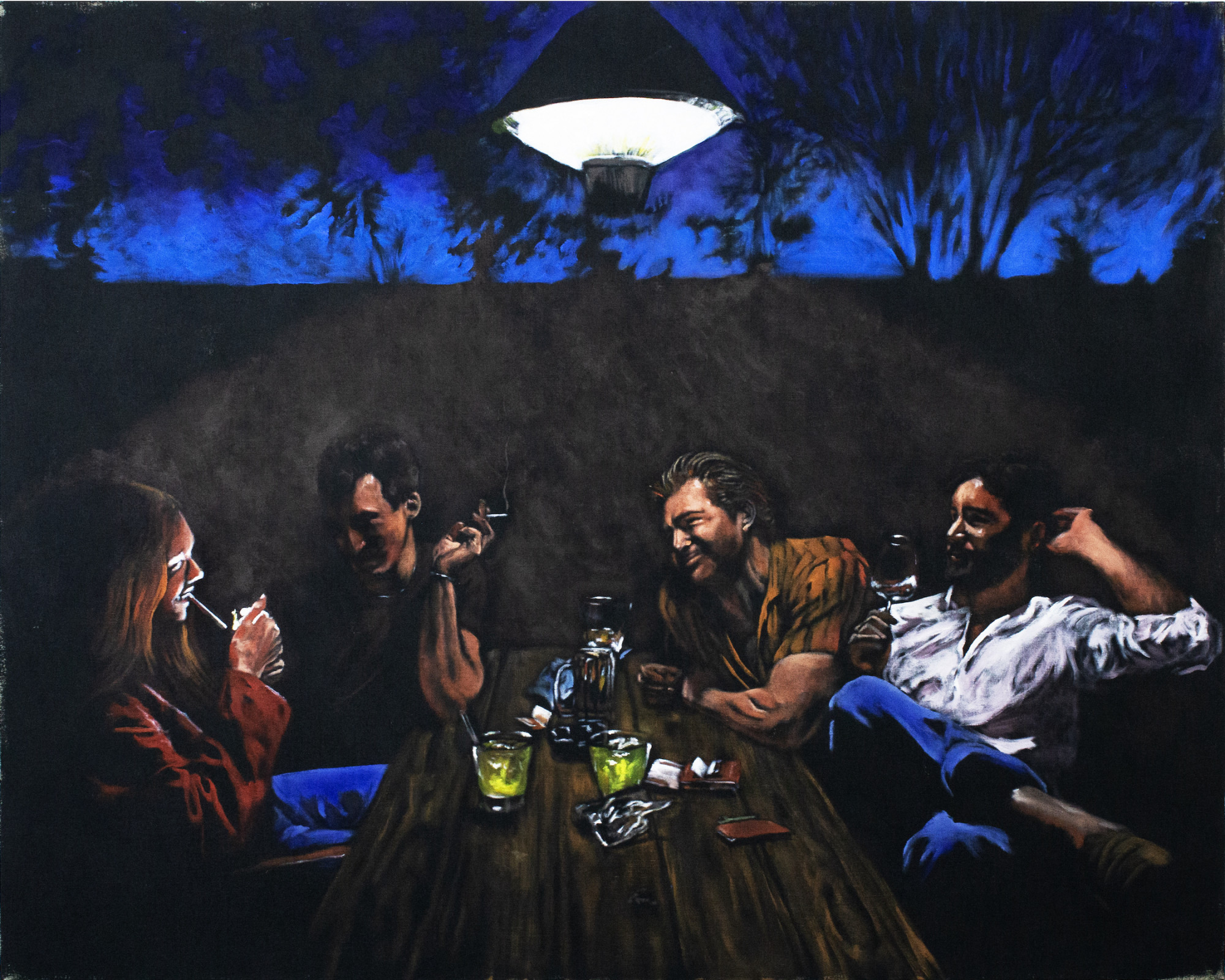Cool Nights and Intimate Cowboys
A conversation with Texas artist RF. Alvarez
By Alyssa Ortega Coppelman

A Familiar Feeling, 2023, acrylic on raw canvas. All work © RF. Alvarez. Courtesy the artist and Taymour Grahne Projects
At some point in the blur of the past few years, I came across Texan painter RF. Alvarez’s dreamy, longing, mostly nocturnal, sometimes sedate work—whether it was on Instagram or via an exhibition announcement, I will never remember. What I do remember is the visceral reaction his work provoked. It wasn’t the subject matter alone—scenes from a queer man’s life with his husband and their extended circle of friends. In fact, artwork by queer artists of queer subjects has experienced somewhat of a boom in recent years, thank goodness. In the case of Alvarez’s work, what struck me was the frequency of cowboy hats, the exploration of machismo associated with both Texan and Latin American cultures merged with the ephemeral quality and queer subject matter of his paintings. There is an inherent fleetingness gained from softer edges that also, somehow, reinforces intimacy and an ease that can only exist on an established foundation of belonging, safety, and freedom to explore one’s identity.
Alvarez employs a velvety darkness that his subjects, whether people or a field of flowers, simultaneously emerge from and recede into. To achieve this, he first primes raw linen canvases with black acrylic paint for its matte quality, with which he cultivates a wide depth of field, pulling his subjects out of the darkness, but only just enough. Occasionally his shadows provide a somber quality, but overall, the feeling is one of winding down—dinner parties with friends, honky-tonking, lounging at a picnic table, somewhere in Alvarez’s Austin, Texas, where cooler nighttime temperatures offer both opportunity and respite. In his few daytime paintings, Alvarez’s figures often rest in the shadows—lying on the grass in the broad shade cast by the branches of a live oak; enjoying an intimate encounter outdoors, surrounded by foliage, bodies dappled with sun or moon or streetlight through the leaves. Or, lying in bed during the day, post- or pre-coital, slumbering or restful—figures enfolded in luxurious shadow near windows that frame the sunlit plant life outside. They exist between the darkness and light, and it suits them.
I was surprised to learn that Alvarez has only been painting seriously for five years, given the relatively rapid development of his early, simplified style into his recent, more detailed canvases. In college, he didn’t study art but did start an arts and culture magazine with fellow students. Post-college, he got work at agencies as a branding and graphic designer before starting his own design business. In 2015, he began selling his early, abstract work online with a gallery and, five years ago, was able to quit all else and begin painting full-time.
Alvarez welcomed me to his East Austin studio, where we looked at his newest work and spoke about the trajectory of his painting practice.
Alyssa Coppelman: Let’s talk about the frequency of men wearing cowboy hats, or the cowboy-like figures in your work.
RF. Alvarez: My mom’s family are cattle ranchers, seven generations, long history of cattle ranching. For starters, the expectation I grew up with [of working on the ranch]. I grew up in the shadow of my grandfather who was a cowboy, and [it’s about] my inadequacy or my failure to be that.
Does your mom have brothers who are still working the ranch?
My uncle is still working the ranch. But I think he struggled with my grandfather, who was a very cold man. He was gregarious and happy and fun out in public, and then with the men in his life he was pretty distant, which was hard. Something that plays into my work constantly is this feeling of inadequacy with all that, and I honestly think that’s just what it is to be a man—a lot of times it’s just constantly feeling inadequate. I mean, the boys are not alright.
Central to that is this deep, intense expectation around your emotions and your body and how you’re supposed to hold yourself, and I’m interested in showing vulnerability and embracing that tenderness. The cowboy hat is the icon of that vision of masculinity—the cold, stoic thing—and I like taking the icon and turning it into camp. I like reappropriating it and making it my own.
In The Afterparty, Maggie, my non-binary friend, is wearing the cowboy hat. I always like putting Maggie in the hat. In another picture, I’m wearing my grandfather’s hat and his jacket. I’ve done multiple self-portraits wearing my grandfather’s hat, often nude or in underwear. And I think about how the queer body can exist in this space and have it as well. It plays into the history of America.
And in film, and in history, when there were only men on the frontier.
It’s wild how sometimes you see these men who see themselves as so macho in Texas, and they walk in and it looks like drag. In Farewell, Eurydice, to the Man I’ll Never Be, I have a rust-colored handkerchief hanging out of my left back pocket, which is a signal in the gay code. Rust [in the left pocket] means you’re looking for a cowboy.
You were telling me you sense a bit of fatigue in your newest work. Can you say more about that?
It’s like The Afterparty—how long can you continue socializing and being festive? It’s about the joy of lingering, but it’s also the fear of loneliness. And the fear of coming to terms with reality. But it’s a distraction.
Building up towards my solo show [at Taymour Grahne in London], I was looking at Octavio Paz’s The Labyrinth of Solitude. It’s about the American identity versus the Mexican identity, and he has this essay on the fiesta that really expands on it. My dad’s from Mexico, and the next stage for me is figuring out how to address that in my work. One of the things Paz says—speaking specifically of the Mexican identity—is that the fiesta, the revelry, the dancing, is the closest you’ll come to stopping time completely. You’re putting off the future and forgetting the past. You’re the most in the moment, which for him means that you’re the closest to and farthest from death at the same time, because you’ve staved off death through the fiesta. It’s this space outside of time. And it’s why clubbing culture was so central to the queer community during the AIDS crisis.
There’s this idea of going down into the underworld… I think the show is going to start with these visions of the Eden-like landscape, and the snake is the transition point, and then the images of revelry. And the ending place is this look back, this act of saying goodbye or reconciling with what hasn’t been processed along the way.
All of these works for my solo show are loosely based off of the myth of Orpheus going into the underworld. The gods allow Orpheus to visit the underworld to bring his bride Eurydice, who had passed away, back to the land of the living. But he’s forbidden to turn back to look at her. Just when he gets to the precipice before leaving the underworld, he turns and looks at her [and she must remain in the underworld]. Was he so in love with her he couldn’t help himself? Did he not trust that she would follow? Did he not trust the gods? There are a lot of interpretations. My interpretation is that his looking back is an act of letting go. By looking the thing in the eye, you let it go.

The Seed Bearer, 2024, acrylic on raw linen

Farewell, Eurydice, to the Man I’ll Never Be, 2024, acrylic on raw linen
I hadn’t thought about it really, but you have a fair amount of direct eye contact.
I have tended in my more recent work to avoid direct eye contact. This [painting, The Look Back,] shows me revisiting the confrontation with the viewer.
What is that for you, the confrontation with the viewer? Or, what’s the challenge you’re presenting?
I start with this concept of the look back. I often find that after pursuing an idea in the making of the work, the work itself ends up telling me what I’m actually trying to say. It very much comes after the fact. I feel like this show has become more and more about my marriage, my relationship, and, maybe in the same way as Orpheus journeying into the underworld and back, by going out in the world and exploring it and experiencing it, you understand the truth and the complexity of the thing. There’s a refusal of a happily ever after going on in this work. This is me giving up the expectation I had for myself. I am still reconciling here what it is that I’m actually giving up.
I very much see myself as a post-AIDS artist, like I’m painting after the erasure of a generation that didn’t get to tell these stories. You mentioned via email how I am often painting joy and happiness. For me, intrinsic to the queer experience is a tincture of sadness in the joy, and I think that makes it more sweet. I think the act of painting banal moments like this is an act of gratitude, really.
I very much see myself as a post-AIDS artist, like I’m painting after the erasure of a generation that didn’t get to tell these stories.
How did you decide to portray more intimate scenes from your personal life, especially because they mostly show you and your husband?
The transition into painting more intimate things—there was a very clear punctuation mark between the abstract flat works and the work you see now. I was unhappy with the work I was doing—I really needed a marked change. So I decided to throw my own opening…this was in 2021. When I did the show Tender Is the Heart, the thing I was missing in the work was authenticity. I needed vulnerability. In fact, vulnerability is now one of the more important things I’m constantly exploring. You get to a certain point where you paint, you paint, you paint, and it stops being “I’m trying to tell you something” and becomes the work is telling me something—I’m learning about myself by doing all of this. That was the first series of works where I moved into this new style. It was intimate scenes with my husband and Texas landscapes, side by side.
But the most important thing was that after the show, a kid from UT [Austin] who had come to see it sent me a message on Instagram and said that seeing himself in the work gave him the confidence he needed to come out to his parents. I mean… I struggle to tell that without [getting emotional]… I bawled. I cried like a baby.
That’s massive. I mean, how much more can you hope for?
That’s why I enjoy doing figurative work. It’s also why I enjoy painting my life. I feel very much that a first-person narrative might be the best angle for having deeper conversations about the human experience. That was the moment where I transitioned into painting my own experience.
How about the role of mythology in your work? Because it pops up all the time.
I’ve always been a nerd about ancient Greece, ancient Rome. There are two layers to that. One, it’s a very common theme for gay men to be playing with. Think Call Me by Your Name, or look at Derek Jarman’s writing. There are a lot of references to myth. A lot of that has to do with this ideal past where men are having sex with men, and it’s part of society and it’s normal and the gods have sex with men. I think that’s so enticing and delicious to think about as a gay man. What a world to live in where your own god is like you.
The other aspect I’m interested in is the stories we tell and how the human experience is the same again and again and again. In the same way that my perspective is my own experience, but it has so much resonance with people, not just gay men like myself, but so many other people. Because we’re all living through the same stories.
Greek myth is one of the cornerstones of Western ideology, but they’re stories that still resonate and they’re allegory and you can come at them from different angles. I find it fascinating that I can have a conversation through my work with someone from so long ago, maybe about the same thing.
What specifically brings so much plant life into your work?
The ephemerality of something like honeysuckle on a wall. That’s my grandmother’s honeysuckle [in the painting Honeysuckle]. We grew up walking along it and pulling the threads out. It’s a very sensual experience. There’s also something, maybe, to this Garden of Eden safe space. Cruising is a really big part of gay culture. Going out into the woods and being removed from society so you can create a safe space or become your true self, I think, is really a big part of it.
Also, a lot of Greek myth takes place in the woods and surrounded by nature. And then there’s another aspect. There’s this film called Nus masculins, by François Reichenbach. Cinema vérité, a guy with a camera shooting all of his lovers in the woods. There’s something about the freedom, but also the pain. You can see it. You can see that they want so badly to just be themselves, but there’s so much hurt.

The Descent (Mezcal & Cigarettes), 2024, acrylic on raw linen
I’ve been thinking about cultures existing parallel to one another—in this case, gay culture, straight culture. When you’re in the straight world, for the most part, there’s often complete ignorance of what that might mean, and there’s an inability to really truly know. Whereas it’s always the so-called “minority” culture that knows about both sides, since they have no choice but to navigate life in the majority culture.
I hear you. I think for that reason, I’m so grateful that I’m gay. I see queerness as such a gift because it allows you to see the whole society and all of it from the outside. And realize we made a lot of this up. Like, we really just made this up. And a lot of it is actually very alienating. It has nothing to do with what it means to be human. It’s an interesting thing, even being gay men who choose to opt into marriage as buying into that system. I think for us, it was a lot about showing the people on the other side of the aisle my heart, and [showing] straight family members that this is real and it’s just as valid.
Using the language of the colonizer.
Yes, using the language… God. Yeah, yeah. As gay men, we can be having a conversation with straight men about their vulnerability, what it looks like to have given up on the maximum expectation and how much more joyful I am because of it. There’s a conversation that needs to be happening. Again, the boys are not alright. The boys are definitely not alright.
Isn’t it wonderful to see straight men who are able to be loving towards each other? One of the cruelest forces in the world is loneliness, and it’s so central to the male experience. There’s a sociological study about boyhood and, at a certain age as boys develop, they stop having close friends, they isolate themselves. I forget what it’s called, but it’s fascinating, and it’s very true. Straight men really isolate themselves. They lose how to have deep connection, and I think they need to have deep connection with other men and also be able to cross the chasm to be able to show tenderness towards women.
My grandfather didn’t really have any friends. My dad now has one friend. Meanwhile, this is a queer life. It’s surrounded by people, and not all those people are queer. To be surrounded by friends at the afterparty, the time when loneliness can creep in at the end of the night and to have people linger around. I mean, what a blessing. And how I wish that for people.



